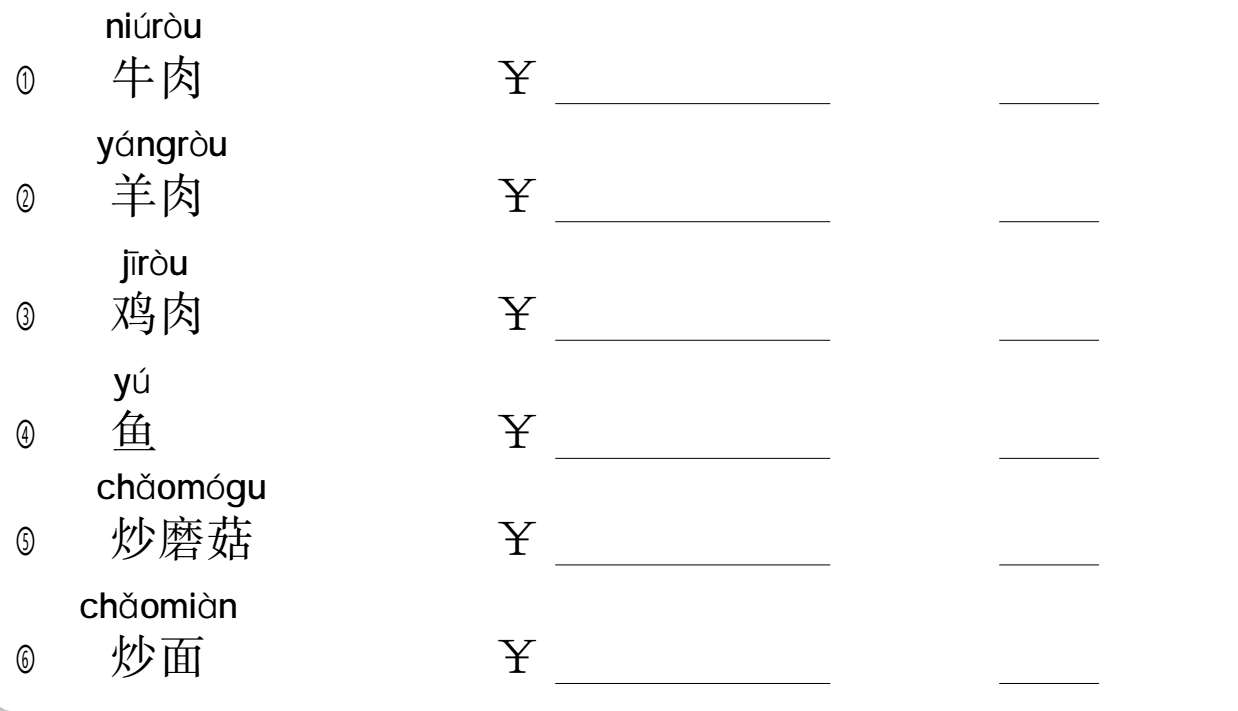




Change the underlined words to make new dialogues.You can use the words in“Useful
Words&Expressions”.(替换画线部分,可用“补充词汇与短语”)
(1)A: 你 要 什 么 ?
B: 我 要 土 豆 。 多 少 钱 ?
A: 两 块 五 。 还 要 什 么 ?
B: 还 要 鸡 肉 。
(2)A: 有 炒 饭 吗 ?
B: 没 有 。 有 白 米 饭 , 要 吗 ?
A: 不 要 。 炒 面 呢 ?
B: 也 没 有 。
(3)A: 那 个 是 包 子 吗 ?
B: 对 , 你 要 吗 ?
A: 要 。
B: 要 几 个 ?
A: 要 两 个 。
(1) 几 包 子 你 要 个 ?
(2) 马 克 吃 喜 欢 的 食 堂 不 饭
(3) 有 和 食 堂 白 米 饭 只 包 子
(1)He is not my classmate.
(2)What else do you want?
(3)A:Is this fish? B:Yes.
(4)A:I don't have money. B:Neither do I.
(5)A:Do you know this person? B:Yes.
(6)A:Do you have beer? B:No. We only have water.
(7)This is not my noodles.I want beef noodles,not chicken noodles.
(1)Listen to four dialogues and write the prices ofthe following food according to what you hear.Then listen again and check the food that the people in the dialogues eventually buy.(听四个对话,写出所听到食物的价格,再听一遍,看看顾客最后都买了些什么?)
Vocabulary (生词)
太 贵 了 too expensive 今 天 n. today
Questions for Conversation

(2)Listen to a dialogue and answer the following questions.(听一段对话,回答问题)
Vocabulary (生词)
少 adj. few,little 多 adj. many,much 早 饭 n. breakfast
Questions for Conversation
① 食 堂 有 什 么 包 子 ?
② 玛 丽 吃 什 么 包 子 ? 她 要 几 个 ?
③ 马 克 吃 什 么 包 子 ? 他 要 几 个 ? 今 天 吃 几 个?
(1)Group work(3-4 people):prepare a 菜 单 in advance with words learned in this unit.Give this 菜 单 to a student(and only this student)in another group.(小组活动:3—4人一组。用本课学过的词事先设计一份菜单,然后把菜单交给另一组中的一个 学生【只给该学生】)
(2)Group work(3—4 people):the student who was given the new menu plays the role of 服 务 员 in 食 堂 ,and the other students play the role of 顾 客 (customers). (小组活动:让另一 组 中得到菜单的那个同学扮演服务员的角色,小组其他成员 扮演顾客的角色)
(3)Pair work:Ask your partner the following questions and then reverse role.(双人练习:用下列问题互相提问)
(1) 你 喜 欢 吃 食 堂 的 饭 菜 吗 ?
(2) 你 喜 欢 吃 什 么 菜 ? 不 喜 欢 吃 什 么 菜 ?
(3) 你 喜 欢 吃 什 么 中 国 菜 ?
(4)Pair work:Read number 1 to 30.One student read the odd numbers and the other the even numbers.The teacher will write down the time each pair takes.(双人练习:读数字1—30,一个学生读单数,另一学生读双数,老师记录各组学生读完1—30所用的时间,看哪个组读得最快)